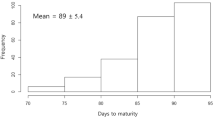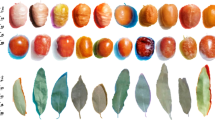Abstract
The primary bioactive components of buckwheat seeds, rutin, and quercetin, have health-related benefits such as anti-inflammatory, antioxidant, anti-diabetic, and anti-cancerous. In the current study, we characterized the agro-morphological traits of diverse tartary buckwheat germplasm accessions under the spring cultivation and estimated the major flavonoid contents of seeds. The content of rutin and quercetin ranged from 4354.1 to 17,196.01 and 8.9 to 611.7 µg g−1 DW, respectively. The highest content of rutin was found in ‘C9714’ collected from China. The highest and lowest content of quercetin was found in Indian accessions ‘I8345’ and ‘I8622’, respectively. Moreover, we found that accessions with dark-brown seed coat color had a significantly higher mean rutin content than that of accessions with other seed coat color. In the principal component analysis, the first three components (PC1, PC2, and PC3) accounted for 77.14% of the total variation. The number of nodes and branches, number of days to flower, and maturity were the main contributors of variability to PC1. The 1000-seed weight was the main contributor of variability to PC2; whereas, the rutin and quercetin were the main contributors of variation to PC3. We identified nine accessions with the rutin content above 10,000 µg g−1 DW and three accessions with quercetin content above 40 µg g−1 DW. The selected accessions could be used as a nutritional source of health-related bioactive metabolites.







Similar content being viewed by others
References
Acar R, Ünver A, Arslan D, Özcan MM, Güneş A (2011) Effect of plant parts and harvest period on rutin, quercetin, total phenol contents and antioxidant activity of buckwheat (Fagopyrum esculentum Moench) cultivated in Turkey. Asian J Chem 7:3240–3242
Arduini I, Masoni A, Mariotti M (2016) A growth scale for basic development of common buckwheat. Acta Agric Scand Sec B-S 66:215–228
Bai CZ, Feng ML, Hao XL, Zhong QM, Tong LG, Wang ZH (2015) Rutin, quercetin, and free amino acid analysis in buckwheat (Fagopyrum) seeds from different locations. Genet Mol Res 14:19040–19048
Baniya BK, Dongol DMS, Dhungel NR (1995) Further characterization and evaluation of Nepalese buckwheat (Fagopyrum spp.) landraces. In: Proceedings of the sixth international symposium on buckwheat. pp 295–304
Bjorkman T (2000) Buckwheat production. Guide to buckwheat production in the northeast. https://www.nysaes.cornell.edu/hort/faculty/Bjorkman/buck/Buck.html
Bonafaccia G, Fabjan N (2003) Nutritional comparison of tartary buckwheat with common buckwheat and minor cereals. Zb Bioteh Fak Univerze v Ljubljani Kmet 81:349–355
Bonafaccia G, Marocchini M, Kreft I (2003) Composition and technological properties of the flour and bran from common and tartary buckwheat. Food Chem 80:9–15
Cai YZ, Corke H, Wang D, Li WD (2016) Buckwheat. Reference module in food science, Elsevier. 10.1016/B978-0-08-100596-5.00034-2
Cepkova PH, Janovska D, Stehno Z (2009) Assessment of genetic diversity of selected tartary and common buckwheat accessions. Span J Agric Res 7:844–854
Chao PL, Hsiu S, Hou Y (2002) Flavonoids in herbs: biological fates and potential interactions with xenobiotics. J Food Drug Analy 10:219–228
Chu JX, Wang ZL, Han SY (2011) The effects of total flavonoids from buckwheat flowers and leaves on renal damage and PTP1B expression in type 2 diabetics rats. Iran J Pharm 10:511–517
Cook NC, Samman S (1996) Flavonoids-chemistry, metabolism, cardioprotective effects, and dietary sources. Nutr Biochem 7:66–76
Fabjan N, Rode J, Košir IJ, Wang Z, Zhang Z, Kreft I (2003) Tartary buckwheat (Fagopyrum tataricum Gaertn.) as a source of dietary rutin and quercetin. J Agric Food Chem 51:6452–6455
Frooq S, Rehman UR, Pirzadah TB, Malik B, Dar FA, Tahir I (2016) Cultivation, agronomic practice, and growth performance of buckwheat. In: Zhou M, Kreft I, Woo SH, Chrungoo N, Wieslander G (eds) Molecular breeding and nutritional aspect of buckwheat. Academic Press, Cambridge, pp 299–319
Germ M, Gaberšcˇik A (2016) The effect of environmental factors on Buckwheat. In: Zhou M, Kreft I, Woo SH, Chrungoo NK, Wieslander G (eds) Molecular breeding and nutritional aspects of buckwheat. Academic Press, Cambridge, pp 273–281
Gimenez-Bastida JA, Zielinski H (2015) Buckwheat as a functional food and its effects on health. J Agric Food Chem 63:7896–7913
Hammer Ø, Harper DAT, Ryan PD (2001) PAST: Paleontological statistics software package for education and data analysis. Palaeontol Electron 4(1): 9. https://palaeo-electronica.org/2001_1/past/issue1_01.htm
Hertog MGL, Kromhout D, Aravanis C, Blackburn H, Buzina R, Fidanza F, Giampaoli S, Jansen A, Menotti A, Nedeljkovic S, Pekkarinen M, Simic BS, Toshima H, Feskens EJM, Hollman PCH, Katan MB (1995) Flavonoid intake and long-term risk of coronary heart disease and cancer in seven countries study. Arch Intern Med 155:381–386
Hyun DY, Rauf M, Lee S, Ko HC, Oh S, Lee MC, Choi YM (2018) Comparison of growth characteristics and flavonoids content by different cultivation seasons in buckwheat germplasm. Korean J Plant Res 31:489–497
Ikeda S, Yamashita Y (1994) Buckwheat as a dietary source of zinc, copper and magnesium. Fagopyrum 14:29–34
Jiang P, Burczynski F, Campbell C, Pierce G, Austria JA, Briggs CJ (2007) Rutin and flavonoid contents in three buckwheat species Fagopyrum esculentum, F. tataricum and F. homotropicum and their protective effects against lipid peroxidation. Food Res Int 40:356–364
Jing R, Li HQ, Hu CL, Jiang YP, Qin LP, Zheng CJ (2016) Phytochemical and pharmacological profiles of three Fagopyrum buckwheats. Int J Mol Sci 17:589. https://doi.org/10.3390/ijms17040589
Joshi BD (2005) Correlation, regression and path coefficient analysis for some yield components in common and tartary buckwheat in Nepal. Fagopyrum 22:77–82
Joshi BK, Baniya BK (2006) A diversity in qualitative traits of Nepalese cultivated buckwheat species. Fagopyrum 23:23–27
Jung GH, Kim SL, Kim MJ, Kim SK, Park JH, Kim CG, Heu S (2015) Effect of sowing time on buckwheat (Fagopyrum esculentum Moench) growth and yield in central Korea. J Crop Sci Biotech 18:285–291
Kapoor G, Avasthe RK, Chettri PK, Gopi R, Kalita H, Rana JC (2018) Multivariate analysis to evaluate common and tartary buckwheat germplasm in Sikkim. Ind J Plant Genet Resour 31:134–141
Kim SJ, Zaidul ISM, Suzuki T, Mukasa Y, Hashimoto N, Takigawa S, Noda T, Matsuura-Endo C, Yamauchi H (2008) Comparison of phenolic compositions between common and tartary buckwheat (Fagopyrum) sprouts. Food Chem 110:814–820
Kiprovski B, Petkovesek MM, Slatnar A, Veberic R, Stampar F, Djordje M, Latkovic D (2015) Comparison of phenolic profile and antioxidant properties of European Fagopyrum esculentum cultivars. Food Chem 185:41–47
Lee CC, Hsu WH, Shen SR et al (2012) Fagopyrum tataricum (buckwheat) improved high-glucose-induced insulin resistance in mouse hepatocytes and diabetes in fructose-rich diet induced mice. Exp Diabetes Res 19:375673
Li C, Kobayashi K, Yoshida Y, Ohsawa R (2012) Genetic analysis of agronomic traits in buckwheat (Fagopyrum tataricum (L.) Gaertn). Breed Sci 62:303–309
Li J, Gong F, Li F (2016) Hypoglycemic and hypolipidemic effects of flavonoids from tartary buckwheat in type 2 diabetic rats. Biomed Res 27:132–137
Li J, Yang P, Yang Q, Gong X, Ma H, Dang K, Chen G, Gao X, Feng B (2019) Analysis of flavonoid metabolites in buckwheat leaves using UPLC-ESI-MS/MS. Molecules 24:1310. https://doi.org/10.3390/molecules24071310
Li SQ, Zhang QH (2001) Advances in the development of functional foods from buckwheat. Crit Rev Food Sci Nutr 41:451–464
Lin LY, Peng CC, Yang YL et al (2008) optimization of bioactive compounds in buckwheat sprouts and their effect on blood cholesterol n hamsters. J Agric Food Chem 56:1216–1223
Liu CL, Chen YS, Yang JH, Chiang BH (2008) Antioxidant activity of tartary (Fagopyrum tataricum (L.) Gaertn.) and common (Fagopyrum esculentum Moench) buckwheat sprouts. J Agric Food Chem 56:173–178
McGraw-Hill C (2008) Statistix 8.1 (analytical software, Tallahassee, Florida). Maurice/Thomas text (ISBN: 0073402818). Analytical Software, Tallahassee
Misra AK, Roy S, Singh SK, Rathi RS, Harish GD (2019) Morphological diversity of buckwheat (Fagopyrum spp.) landraces from Northeast India. Ind J Plant Genet Resour 32:11–17
Morishita T, Yamaguchi H, Degi K (2007) The contribution of polyphenols to antioxidative activity in common buckwheat and tartary buckwheat Grain. Plant Prod Sci 10:99–104
Nam TG, Lee SM, Park JH, Kim DO, Baek NI, Eom SH (2015) Flavonoid analysis of buckwheat sprouts. Food Chem 170:97–101
Nam TG, Lim TG, Lee BH, Lim S, Kang H, Eom SH, Yoo M, Jang HW, Kim DO (2017) Comparison of anti-Inflammatory effects of flavonoid-rich common and tartary buckwheat sprout extracts in Lipopolysaccharide-stimulated RAW 264.7 and peritoneal macrophages. Oxid Med Cell Longev. https://doi.org/10.1155/2017/9658030
Nishimura M, Ohkawara T, Sato Y, Satoh H, Suzuki T, Ishiguro K, Noda T, Morishita T, Nishihira J (2016) Effectiveness of rutin-rich tartary buckwheat (Fagopyrum tataricum Gaertn.) ‘Manten-Kirari’ in body weight reduction related to its antioxidant properties: a randomised, double-blind, placebo-controlled study. J Funct Foods 26:460–469
Oomah BD, Mazza G (1996) Flavonoids and anti-oxidative activities in buckwheat. J Agric Food Chem 44:1746–1750
Pantha S, Budhathoki SK, Amgai RB, Khatiwada SP (2014) Variation on Nepalese buckwheat: agro-morphological characteristics. In: Proceedings of the 27th national summer crops workshop, vol 2, 18–20 April
Park BJ, Park JI, Chang KJ, Park CH (2004) Comparison in rutin content in seed and plant of tartary buckwheat (Fagopyrum tataricum). IN: Proceedings of the 9th international symposium on buckwheat. Prague 2004
RStudio Team (2019) RStudio: Integrated development for R. RStudio, Inc., Boston. https://www.rstudio.com/
Sattanathan K, Dhanapal CK, Umarani R, Manavalan R (2011) Beneficial health effects of rutin supplementation in patients with diabetes mellitus. J App Pharm Sci 01:227–231
Senthilkumaran R, Bisht IS, Bhat KV, Rana JC (2008) Diversity in buckwheat (Fagopyrum spp) landrace populations from northwestern Indian Hamalyas. Genet Resour Crop Evol 55:287–302
Sikder K, Kesh SB, Das N, Manna K, Dey S (2014) The high antioxidative power of quercetin (aglycone flavonoid) and its glycone (rutin) avert high cholesterol diet induced hepatotoxicity and inflammation in Swiss albino mice. Food Funct 5:1294–1303
Siracusa L, Gresta F, Sperlinga E, Ruberto G (2017) Effect of sowing time and soil water contents on grain yield and phenolic profile of four buckwheat (Fagopyrum esculentum Moench.) varieties in a Mediterranean environment. J Food Comp Anal 62:1–7
Suzuki T, Honda Y, Funatuski W, Nakatsuka K (2002) Purification and characterization of flavonol 3-glucosidase, and its activity during ripening in tartary buckwheat seeds. Plant Sci 163:417–423
Tang Y, Ding MQ, Tang YX, Wu YM, Shao JR, Zhou ML (2016) Germplasm resources of buckwheat in China. In: Zhou M, Kreft I, Woo SH, Chrungoo N, Wieslander G (eds) Molecular breeding and nutritional aspects of buckwheat. Academic Press, Cambridge, pp 13–20
Vicente O, Boscaiu M (2018) Flavonoids: antioxidant compounds for plant defense and for a healthy human diet. Not Bot Horti Agrobot 46:14–21
Wang L, Yang X, Qin P, Shan F, Ren G (2013) Flavonoid composition, antibacterial and antioxidant properties of tartary buckwheat bran extract. Ind Crop Prod 49:312–317
Wieslander G, Fabjan N, Vogrincic M et al (2011) Eating buckwheat cookies associated with the reduction in serum level of myeloperoxidase and cholesterol: a double blind crossover study in day-care center staffs. Tohoku J Exp Med 225:123–130
Yu HJ, Kwon SJ, Choi JY, Ju YH, Roy SK, Lee DG, Park CH, Woo SH (2019) Variation of rutin and quercetin contents in tartary buckwheat germplasm. Fagopyrum 36:51–65
Zhang L, Li X, Ma B, Gao Q, Du H, Han Y, Li Y, Cao Y, Qi M, Zhu Y, Lu H, Ma M, Liu L, Zhou J, Nan C, Qin Y, Wang J, Cui L, Liu H, Liang C, Qiao Z (2017) The tartary buckwheat genome provides insights into rutin biosynthesis and abiotic stress tolerance. Mol Plant 10:1224–1237
Zhu F (2016) Chemical composition and health effects of tartary buckwheat. Food Chem 203:231–245
Acknowledgements
This study was supported by the “Research Program for Agricultural Science & Technology Development (Project No. PJ012478)” of the National Institute of Agricultural Sciences, Rural Development Administration.
Author information
Authors and Affiliations
Contributions
Conceptualization and design of the work were done by DYH, OS, and M-CL; methodology and data curation were done by SL, HY, MR; data analysis and writing original draft were done by MR; writing-review and editing were done by Y-MC.
Corresponding authors
Ethics declarations
Conflict of interest
The authors declare that they have no financial or competing interests.
Rights and permissions
About this article
Cite this article
Choi, YM., Yoon, H., Lee, S. et al. Characterization of Agro-morphological Traits of Tartary Buckwheat Germplasm Under Spring Cultivation and Analysis of Health-Related Primary Bioactive Components in Seeds by HPLC Method. J. Plant Biol. 64, 87–98 (2021). https://doi.org/10.1007/s12374-020-09286-y
Received:
Revised:
Accepted:
Published:
Issue Date:
DOI: https://doi.org/10.1007/s12374-020-09286-y




